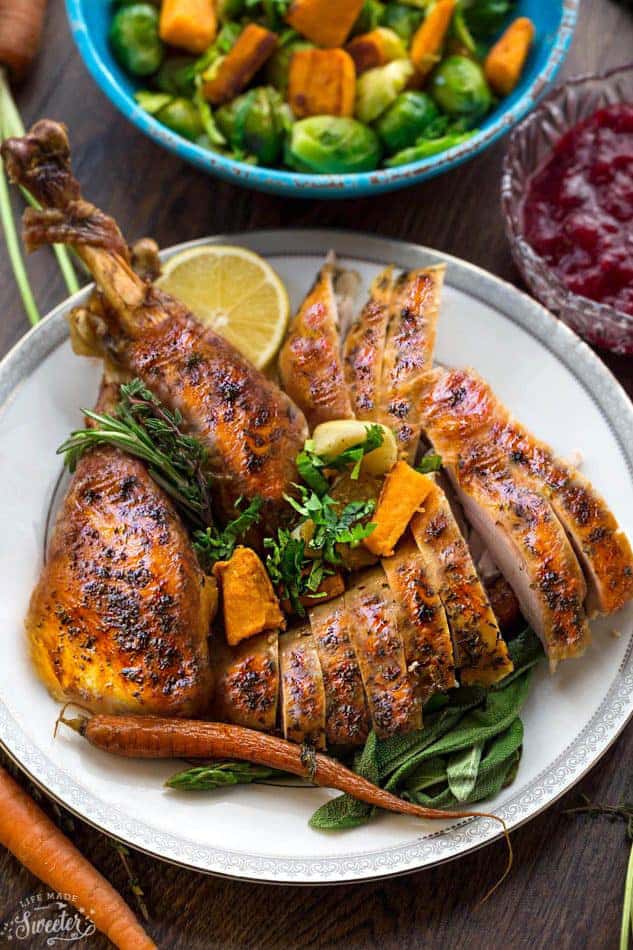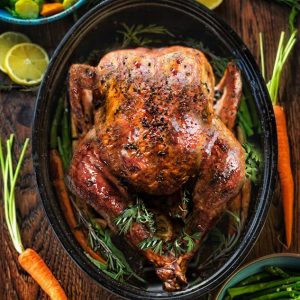This Thanksgiving Turkey is perfectly juicy, tender and packed with fresh herbs, aromatic vegetables, and a flavorful creamy herb butter that promises a mouthwatering holiday centerpiece for your Thanksgiving feast. It’s a simple and foolproof recipe that everyone should have at their fingertips as the holidays approach.

PIN HERE for later and follow my boards for more recipe ideas
Updated November 2023
The Perfect Thanksgiving Turkey Recipe
Are you ready to elevate your Thanksgiving feast with a turkey that’s succulent, flavorful, and a showstopper on your table? Look no further – this Thanksgiving Turkey recipe is here to make your holiday celebration unforgettable. Packed with aromatic herbs, garlic-infused butter, and a medley of fresh vegetables, this herb turkey recipe promises a culinary experience that will have your guests coming back for seconds.
There are few things in life better than a perfectly-cooked Thanksgiving turkey. The juicy, tender meat, the rich flavors, the scent filling up your home … what could be better? But unfortunately, there’s nothing more disappointing than a poorly-cooked Thanksgiving turkey.
Turkey can be a finicky meat. It’s not hard to underseason it or overcook it, and either of those things will leave you with a disappointing tray at the center of your Thanksgiving table. But roasting the perfect turkey for the holidays doesn’t need to be an ordeal. Making a perfect Thanksgiving turkey can actually be very straightforward, and it doesn’t even include brines, smokers, deep fryers, or whatever the latest trend is.
Follow a few simple guidelines and use quality ingredients, and you’ll end up with a spectacular piece of meat headlining your Thanksgiving menu.

Ingredients You’ll Need
Here are all the ingredients you need to make the best Thanksgiving turkey. Make sure to check out the recipe card at the bottom of the article to see the exact amounts of each ingredient.
For the Turkey:
- Whole Turkey: A centerpiece for your Thanksgiving table, offering tender, juicy meat. You want to use a 12-14 pound turkey.
- Fresh Sage, Thyme, and Rosemary: A trio of aromatic herbs that infuse the turkey with earthy, savory notes.
- Onions: Yellow or sweet onions are best for this turkey, but white onions, red onions, and shallots will all work.
- Carrots and Celery: These vegetables add sweetness, depth, and texture to your turkey.
- Lemon: A burst of citrusy brightness to balance the richness of the turkey.
- Low-Sodium Chicken Broth: Ensures a moist and delectable turkey, with the bonus of flavorful pan juices. You can make your own chicken stock or opt for a premade stock.
Garlic Herb Butter
Prepare a garlic herb compound butter that will take your roasted turkey to the next level. This heavenly concoction includes:
- Unsalted Butter: The base for a rich, luscious coating. You can also use ghee or vegan butter for a dairy-free option.
- Chopped Fresh Rosemary, Sage, Thyme, and Parsley: A medley of herbs for a flavor explosion.
- Minced Garlic: Introducing a depth of savory goodness.
- Sea Salt and Freshly Ground Black Pepper: Elevating the taste with the perfect balance of seasoning.
Instructions: How to Make Thanksgiving Turkey
Here are all the steps for making a perfectly moist and juicy turkey this thanksgiving.
- Prep the turkey in advance: Defrost the turkey in the fridge, which could take 2-3 days. Once the turkey is fully thawed, remove the neck and giblets, rinse, and pat dry.
- Make the butter: Add the butter, salt, pepper, garlic, parsley, rosemary, sage, and thyme to a bowl. Stir together until everything is well mixed.
- Butter the turkey: Carefully loosen the skin from the turkey breast, separating it from the meat. Then repeat this process on the neck and thighs. Rub half of the butter mixture on the turkey, in between the skin and the meat. Add some sage and thyme under the skin as well, then tie the turkey’s legs together, and tuck the wings underneath the bird.
- Finish seasoning the turkey: Fill the cavity of the turkey with some of the onions, carrots, celery, sage, thyme, rosemary, and lemon. Melt the remaining herb butter in the microwave, then brush it over the turkey skin.
- Prepare the pan: Put the rest of the onion, carrots, and herbs in the roasting pan around the turkey, and then add the chicken broth.

- Prep the oven: Preheat your oven to 425F, with a rack on the lower third.

- Roast the bird:Place the roasting pan in the oven and cook the turkey for 45 minutes, then drop the oven temperature to 350F. Roast the turkey until a meat thermometer inserted into the thigh reads 180F. This will usually take 2-2.5 hours, but it depends on your oven and the size of your turkey. As the turkey roasts, baste it with the broth and drippings in the pan every 30 minutes. Once it reaches temperature, remove the turkey from the oven, let it rest, and then serve.
Tips For Success
A huge part of mastering the Thanksgiving turkey is technique. Here are some tricks and tips to make sure that your holiday bird comes out perfectly.
- Plan ahead: Most people buy frozen turkeys, which are just as good of quality as non-frozen poultry. However, it’s important to plan ahead if you bought a frozen turkey. Because turkeys are so big, it will take them about 2-3 days to defrost in the fridge. Make sure you pull your turkey from the freezer with plenty of time to spare, and leave it in the fridge until the big day. Don’t ever try to defrost a turkey, or roast it while it’s still frozen.
- Don’t skimp on basting: Basting your turkey is the best way to season it, and also the best way to create the crispy skin that people fight over (it’s the best part of the turkey!). Baste every 30 minutes, and make sure that you baste thoroughly, so that the fat and juices run all over the turkey. If you don’t have a baster, just use a spoon to scoop the liquid at the bottom of the pan.
- Add enough stock: A lot of people make the mistake of not adding stock to the roasting pan, or not adding enough. Don’t make that mistake! The stock in the pan not only provides flavor when you baste the turkey, but it helps keep the meat moist as it bakes.
- Tent: Keep a close eye on your turkey. If you notice that it’s getting too brown, and is still a ways away from being done, then cover it in aluminum foil. This will keep the skin from getting too dark and burnt.
- Rest the turkey: It’s very important that you rest the turkey after taking it out of the oven. This herb butter turkey calls for resting the meat for 15 minutes, but if you have the time, 30 minutes is preferable. When you cook meat, the heat causes the juices to be pushed out to the edge of the meat. If you cut into the meat as soon as you finish cooking it, all of those juices will spill out, leaving you with a dry turkey. By resting the meat, you allow time for the turkey to reabsorb all of those flavorful juices, which makes for a more moist and tender turkey, as well as one that tastes a lot better.
Make-Ahead Tips: Stress-Free Turkey Day
Navigate the holiday hustle with these make-ahead tips to streamline your Thanksgiving preparations:
Prep the Herbed Butter in Advance: Mix the garlic herb butter a day ahead and refrigerate, allowing the flavors to meld for an even more aromatic turkey.
Chop Vegetables Early: Save time on the big day by chopping the onions, carrots, and celery the night before. Store them in the refrigerator until ready to use.
Truss the Turkey Ahead of Time: Trussing can be done a day ahead, ensuring your turkey is ready to go into the oven with minimal last-minute fuss.
Make a Cooking Schedule: Plan your cooking schedule, noting when to baste, tent with foil, and check the turkey’s temperature. This keeps the process organized and stress-free.

What to Do With Leftovers
One of the very best things about Thanksgiving turkey is the leftovers. But what should you do with leftover roast turkey? Here are a few suggestions.
- Make meals with the leftovers: There’s no shortage of delicious recipes that you can make with an abundance of leftover turkey. Simply reheating leftovers, or making a simple turkey and cranberry sauce sandwich is a great way to use leftover poultry. But you can also try a more complex recipe, like unstuffed turkey and cabbage casserole, turkey ramen noodle soup, or one skillet turkey Tex Mex casserole.
- Freeze it: If you want to have leftover turkey meat for a while, cut it into slices and freeze it. I like to freeze my turkey in small batches, so I can defrost a little bit at a time whenever I want deli meat for a sandwich.
- Make gravy: It’s not just the leftover turkey that you’ll want to keep, but also the drippings in the pan. You can use them to make a super simple but heavenly, rich gravy. All you need to do is make a roux with butter and flour, then add the drippings and stir until combined. Slowly pour in chicken stock, then season with salt and pepper, and it’s done!
- Make stock: When you carve the turkey meat off the bones, don’t throw the bones away. Instead, keep them to make a stock that is better than any you’ll find in the store.
How to Store and Reheat Thanksgiving Turkey
Refrigeration: Leftover Thanksgiving turkey will last in your fridge for 4 days. You can store it in the fridge by covering the roasting pan in plastic wrap, or by carving the entire turkey and placing it in an airtight container or bag. To reheat slices of turkey, cook them in a 400F oven for 3-5 minutes, until warmed through.
Freezer: You can also store leftover turkey in an airtight container in the freezer for up to 4 months. Thaw overnight in the fridge before using. If you’re going to make a stock, you can store the turkey carcass and bones in an airtight container in the fridge for up to 1 year.

Serving Suggestions: Elevate Your Thanksgiving Spread
Beyond the classic pairings, consider these creative serving suggestions to elevate your Thanksgiving feast:
Cranberry Sauce: Add a refreshing twist with our homemade cranberry sauce, providing a burst of citrusy sweetness.
Maple Glazed Carrots: Complement the savory turkey with the natural sweetness of maple-glazed carrots, offering a delightful contrast.
Wild Mushroom Gravy: Upgrade your gravy by incorporating wild mushrooms for an earthy, umami-rich flavor that enhances the turkey experience.
Pumpkin Sage Biscuits: Introduce a seasonal touch with pumpkin sage biscuits, a delightful alternative to traditional dinner rolls.
Brussels Sprouts with Bacon: Crispy bacon and roasted Brussels sprouts bring a savory crunch to the table, balancing the richness of the turkey.
Variations to Suit Your Taste: Culinary Exploration
Customize your roasted turkey experience with these variations:
Citrus Infusion: Replace the lemon with orange or grapefruit halves for a citrusy twist that complements the herbs.
Spicy Garlic Butter: Add a kick by incorporating crushed red pepper into the garlic herb butter for a spicy, flavorful profile.
Herb Mix and Match: Experiment with different herb combinations, such as tarragon, oregano, or marjoram, to tailor the flavor to your liking.
Wine-Basted Turkey: Enhance the pan juices by incorporating a splash of white wine for a sophisticated depth of flavor.
To Brine or Not to Brine: Deciding Your Turkey’s Fate
In the quest for the perfect Thanksgiving turkey, the age-old dilemma of whether to brine or not emerges. Brining, a process of soaking the turkey in a saltwater solution, has fervent advocates and staunch opposers. Here’s a quick summary to help you navigate this culinary crossroads:
Brining: Moisture Infusion
Pros:
- Moisture Retention: Brining enhances the turkey’s ability to retain moisture during cooking, preventing dryness.
- Flavor Enhancement: The saltwater solution, often infused with herbs and aromatics, imparts subtle flavors to the meat.
- Even Seasoning: Ensures uniform seasoning throughout the turkey for a balanced taste.
Cons:
- Additional Effort: Brining adds an extra step to the turkey preparation process.
- Refrigerator Space: Requires ample refrigerator space for the turkey to soak in the brine.
No Brine: Embracing Simplicity
Pros:
- Convenience: Skipping the brine simplifies the turkey preparation process, saving time and effort.
- Herb and Butter Infusion: A well-prepared garlic herb butter, applied under the turkey’s skin, can deliver rich flavors without the need for brining.
Cons:
- Potential Dryness: Without brining, there’s a risk of the turkey being less moist compared to a brined counterpart.
- Less Flavor Infusion: The flavors may not penetrate as deeply into the meat without the brining process.
Middle Ground: Exploring Alternatives
Dry Brining: Rubbing the turkey with a mixture of salt and herbs without using a liquid brine.
Garlic Herb Butter Infusion: Our recipe incorporates a flavorful garlic herb butter applied under the skin as an alternative to brining.
Frequently Asked Questions (FAQs): Your Turkey-Troubleshooting Guide
Q: How long should I thaw a frozen turkey? A: Allow 2 to 3 days for full defrosting in the refrigerator. Ensure the giblets and neck are removed before rinsing and patting the turkey dry.
Q: How do I prevent the turkey from over-browning? A: Tent the turkey loosely with foil during the last 30 minutes of cooking, or earlier if it browns too quickly.
Q: Can I make the herb butter with plant-based alternatives? A: Absolutely! Substitute plant-based butter for a vegan-friendly option without compromising on flavor.
More Dishes For Your Thanksgiving Table
Here are some other traditional Thanksgiving dishes that you can serve next to your perfectly roasted turkey.

This Thanksgiving Turkey is perfectly juicy, tender and packed with fresh herbs, aromatic vegetables, and a flavorful creamy herb butter that promises a mouthwatering holiday centerpiece for your Thanksgiving feast. It's a simple and foolproof recipe that everyone should have at their fingertips as the holidays approach.
- 1 12-14 pound whole turkey , giblets + neck removed, rinsed + patted dry
- 6 fresh sage leaves , divided
- 5 fresh thyme sprigs , divided
- 2 sprigs fresh rosemary
- 3 medium onions , cut into wedges
- 5 medium carrots , cut into 2″ inch pieces
- 4 celery ribs , cut into 2″ inch pieces
- 1 lemon , halved
- 4 cups low-sodium chicken broth or homemade chicken stock
- 3/4 cup unsalted butter , at room temperature. You can also use ghee or vegan butter for a dairy-free option.
- 1-1/2 Tablespoons chopped fresh rosemary
- 1-1/2 Tablespoons chopped fresh sage
- 1-1/2 Tablespoons chopped fresh thyme leaves
- 1 Tablespoon chopped fresh parsley
- 5 cloves garlic minced
- 2-3 teaspoons sea salt
- 1 teaspoon black pepper
Allow 2 to 3 days for it to fully defrost in the refrigerator. Remove giblets & neck, rinse & pat dry.
In a medium bowl, combine butter, rosemary, sage, thyme, parsley, garlic, salt, and black pepper. Stir together until smooth and combined.
Carefully loosen the skin from the turkey breast with your hands lifting and separating the meat. Do the same for the neck as well as the thighs and legs. Gently rub half of the butter under the skin using your hands and fingers and place 3 sage leaves and 2 thyme sprigs under the skin. Tie the legs together and tuck the wings underneath the turkey, using small skewers to secure, if necessary.
Place 1/3 of the onions, celery, carrots, 2 sage leaves, 2 thyme sprigs, 1 rosemary sprig and lemon halves inside the cavity of the turkey. Place turkey, breast side up in a large roasting pan. Melt the remaining butter in the microwave and brush an even layer over the skin of the turkey. Arrange remaining carrots, celery and herbs in the pan around the turkey. Pour chicken broth in the bottom of the roasting pan (will be using liquid to baste turkey).
Preheat oven to 425°F and position rack on lower third of the oven. Once the oven is ready, place the roasting pan with the turkey into the oven and cook for 45 minutes uncovered.
After 45 minutes, reduce the oven temperature to 350°F and continue to roast until a meat thermometer (inserted deep into the thigh but away from the bone) reads 180°F and juices in the thigh run clear when pierced with a fork, about 2 to 2.5 hours (or longer depending on your oven and size of your turkey), basting with pan broth & drippings every 30 minutes.
Cover loosely with foil the last 30 minutes of cooking or if turkey browns too quickly. Once the turkey is done, remove pan from oven. Carefully transfer turkey from the pan onto a baking sheet and allow to rest for 15 minutes before carving. Strain and reserve pan juices for gravy, if desired, and discard vegetables.
Recipe Video
*Carrots and celery can be prepared in advance to save time
*Compound butter can be made ahead of time and placed in a covered container in the refrigerator


 Did you try this recipe?
Did you try this recipe?






Miranda -
I made this recipe last year for friendsgiving anD my friends have not Stopped talking about it for a full year! Best turkey recipe ive tried and the only recipe i will tRy moving forward!
Dannhi NguYen -
Looks good! Im going to try this recipes and let you Know!